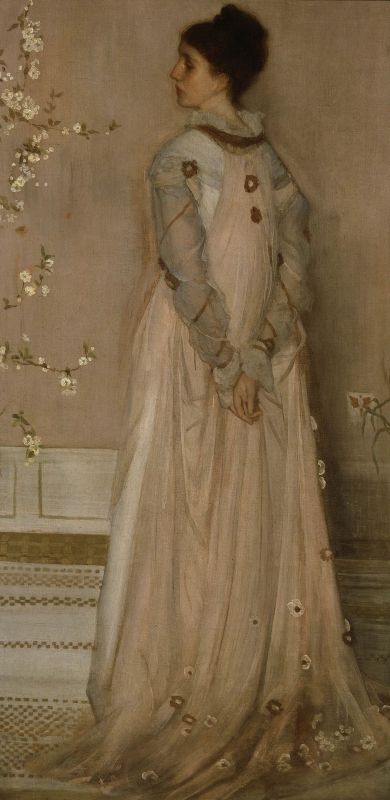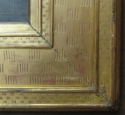Home > Catalogue > Browse > Symphony in Flesh Colour and Pink: Portrait of Mrs Frances Leyland << >>
Composition
Galassi notes a connection to an etching by Whistler:
'In 1870 Whistler began one of his most beautiful and haunting etchings entitled Speke Hall, carrying it through ten states. A figure, generally considered to be Frances Leyland, appears in the foreground of the first state of the print, fashionably attired in a formal day dress with a train and a broad-rimmed hat. She is depicted from behind, small and alone, looking back at the imposing façade of Speke Hall in a winter landscape. The engraving sounds notes that are developed in his oil portrait of Mrs. Leyland.' 1
According to the Pennells, Mrs Leyland wanted to pose dressed in black velvet like Helen Rose Huth (1837-1924) in Arrangement in Black, No. 2: Portrait of Mrs Louis Huth [YMSM 125]. 2
Whistler made two drypoints of Mrs Leyland in such a dress in 1873, The Velvet Dress (Mrs Leyland) [120] and The Little Velvet Dress [119]. However, he designed a very different dress for the oil portrait.
There are numerous crayon studies of Mrs Leyland in various costumes and poses. An early design shows Mrs Leyland seated [M.0429], and some show her standing, facing the viewer, but most show her standing, in profile or turning away from the viewer.
There are a lot of drawings of Mrs Leyland and designs for the dress, including Figure Reading [M.0428], Study of Mrs Leyland [M.0430], Study for 'Symphony in Flesh-colour and Pink: Mrs F. R. Leyland' [M.0431], Mrs Leyland, standing holding a fan [M.0432], Study for 'Symphony in Flesh-colour and pink: Mrs F. R. Leyland' [M.0433], Mrs Leyland [M.0436], Mrs Leyland, standing, holding a book [M.0437], and Mrs Leyland, standing, head turned to the front [M.0438].
Whistler designed the dress in harmony with her auburn hair. There are drawings showing his early ideas for an elaborately gathered and beribboned dress in orange and white chiffon, with a train, and with an overskirt pulled up in flounces over a long skirt scattered with flowers, and flowers in her hair. These show her from different angles.
Studies of details include Study of Rosettes for Lady's Dress [M.0434], Rosettes [M.0435], and a sketch on the verso of a nude study, r.: Nude standing; v.: Designs for rosettes on Mrs Leyland's dress [M.0439].
Some of the details were retained – the puffed sleeves and scattered flowers – but the dress was simplified and the colour scheme changed from orange to pink.
Technique
A recent visual examination by Professor Joyce H. Townsend, Tate Britain, provides useful information:
'The weave of the unlined canvas (unusually fine, with slubs) is very obvious in the background, which is applied over a pink imprimatura.
The artist used highly-thinned paint and a 12.7 mm (½") brush to depict the two layers of chiffon fabric, which remain unresolved at the train. There is no evidence for the use of megilp or Whistler’s 'sauce'.
The figure was painted first, then the dado and floor, up to the gown. The upper layer of chiffon depending from shoulder level was applied after some of the paint of the sleeves, though logically the fabric should be beneath them. The appliqué flowers were painted onto this after the paint dried. The almond blossoms, the butterfly and its leaves were applied to dried paint. The carpet and wall details were applied up to the portrait.' 3
The paint, thin in consistency, has dripped in places, down Mrs Leyland's left arm and over the dado on the right. The leaves are painted with a thin glaze of colour, like watercolour. The pattern of the matting, which is echoed in the pattern on the frame, is also painted thinly, but very precisely, with a small square brush. The blossoms and rosettes were painted with more impasto. The painting was done very freely, but it was also rubbed down and repainted frequently. The canvas is nearly bare of paint down the right side of the skirt.
There are a number of pentimenti. The head was originally a little (some 15mm) further to the left and lower, and was bent further forward. The head may also have been tried out further to the right. There was extensive reworking on both sides of the shoulders. The gown, at her waist, was also further to the right, and was thoroughly wiped back, but not scraped down. The position of several rosettes was changed on her back and below her hands. The folds of the dress were altered, and the outline of the skirt on the left, and at the hem, remains blurred. Several of the green branches in the top left corner were painted over.
The colour was also changed a little. There are traces of orange and brown in the outline of the dress that are now nearly effaced, and many of the rosettes were repainted.
The Pennells wrote that:
'The matting on the floor, the dado, and the spray of almond blossoms are more elaborately carried out than the detail in any other portrait. What worried him, and probably prevented the picture being finished, are the hands, which are almost untouched.' 4
In fact Whistler made studies of hands that may relate to the portrait. In the final state of the oil, the hands are carefully outlined and modelled solidly in two flesh tones. They were not painted freely, but appear to be finished, and indeed, both the head and hands are highly finished.
Conservation History
It was heavily varnished before it was cleaned by the present owners. 5
The Frick conservation records state that in 1922 it was noted that the surface was wrinkled; in 1933, blooming was noted; and the surface was cleaned and varnished in 1935. In 1938 George L Stout noted the canvas as having 20 or more threads/cm, and a thin grey absorbent ground, and that it was strip lined but never given a full lining. In 1942 William Suhr removed three varnishes, applied a new varnish and a new stretcher, and in 1973 he repaired and retouched an old tear. In 1980 John Brealey spit-cleaned the varnish. 6
Frame
1874: Flat Whistler, with large and small basket weave patterning incised on the frieze and fillets, possibly made by Frederick Fox. 7
Flat Whistler, dating from 1874 [15.2 cm], with two narrow outer panels decorated with a small basket-weave pattern, and a broader central panel with a larger similar pattern.
The patterning of the mat depicted in the canvas (and placed on the floor of the Flemish Gallery), was repeated on the frame of Symphony in Flesh Colour and Pink: Portrait of Mrs Frances Leyland [YMSM 106], and on that of Harmony in Grey and Green: Miss Cicely Alexander [YMSM 129], serving as an important link between the painted world of the sitters and that of the viewer.
Notes:
1: Galassi 2003, op. cit. In later states of the etching the model may have been Maud Franklin, who is said to have posed for the oil portrait of Mrs Leyland when she was unable to pose.
2: Pennell 1908 [more], vol. 1, p. 177.
3: Prof. J. H. Townsend, report, May 2017.
4: Pennell 1908 [more], vol. 1, p. 178.
6: The Frick conservation and curatorial records, noted by Prof. J. H. Townsend.
7: Dr Sarah L. Parkerson Day, Report on frames, 2017; see also Parkerson 2007 [more].
Last updated: 27th April 2021 by Margaret
























